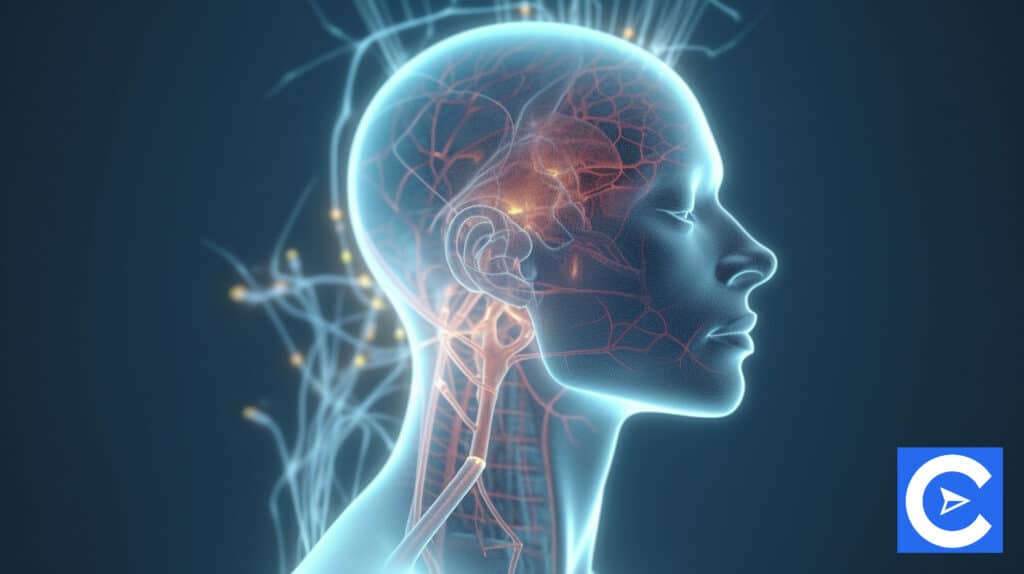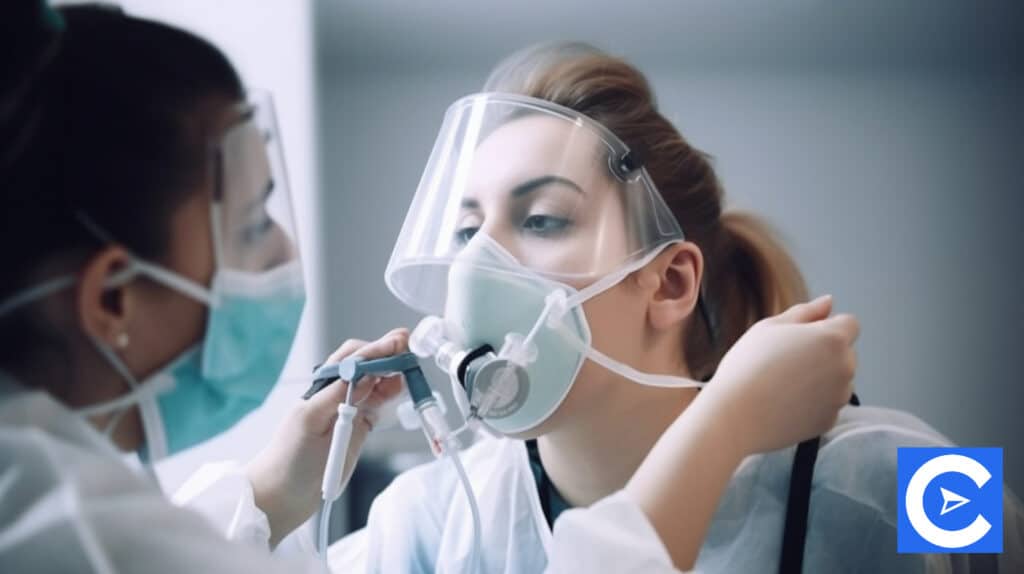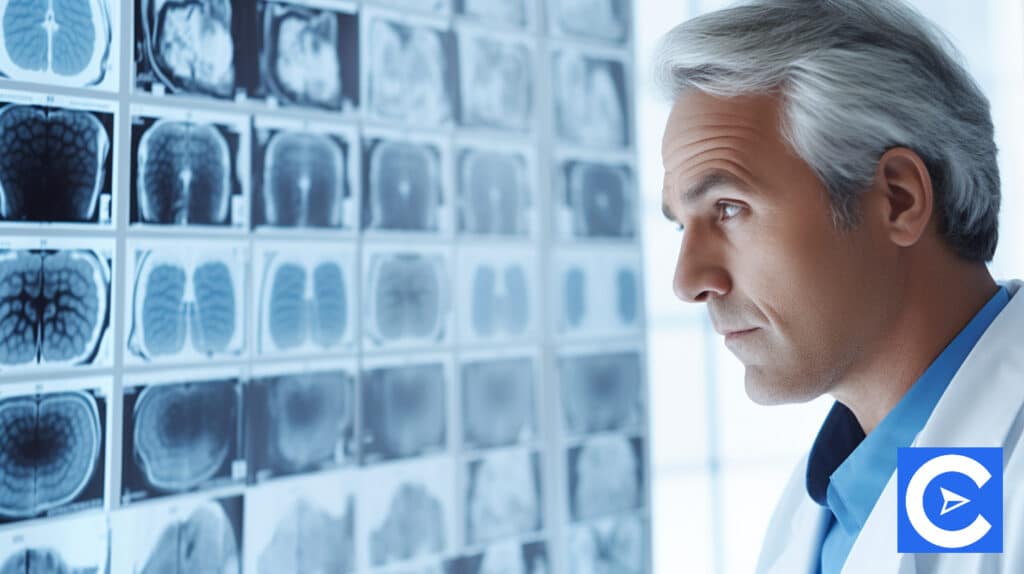Other Free NCLEX RN Study Guides:
There are 8 Modules in NCLEX RN Study Guide. Here you can navigate all the NCLEX RN Study guide modules.
- NCLEX Study Guide Home
- Module 1 | Managing Care Of the Patient
- Module 2 | Overall Safety and Control of Infections
- Module 3 | The promotion of health and maintenance
- Module 4 | Integrity in psychosocial functioning
- Module 5 | Providing Basic Care and Ensuring Patient Comfort
- Module 6 | Therapies: Pharmacological and parenteral
- Module 7 | Potential risk reduction
- Module 8.1 | Adapting physiologically
- Module 8.2 | Adapting physiologically
- Module 8.3 | Adapting physiologically
let’s get started right away.
Carotid artery stenosis, myocardial infarctions, and ACS

Acute coronary syndrome (ACS)
This relates to the coronary arteries and specifically when there is an impairment of blood flow through them.
As a result, this will lead to ischemia of the cardiac muscle which results in angina in the most serious of cases.
Symptoms in elderly patients, females, and diabetics can be less acute.
These usually manifest themselves as pain/numbness/weakness in the arms, nausea, vomiting, and shortness of breath.
There are three angina classifications that you should be aware of:
- Stable angina
- Unstable angina
- Variant angina
Myocardial infarctions
Non-ST-segment elevation MI (NSTEMI)
As a result of myocardial damage from severe ischemia or infarction, an ECG will show ST elevation.
If this elevation is not present, this could indicate NSTEMI or unstable angina.
Note, however, that indications of a partial blockage of coronary arteries, with damage as a result of NSTEMI, will raise cardiac enzyme levels.
For unstable angina, symptoms would include tightness or pain in the chest which moves into the arms from down the neck, anxiety, dyspnea, dizziness, weakness, vomiting, heartburn, and nausea.
Treatment initially includes beta-blockers, nitroglycerin, antiplatelet agents, and antithrombotic agents.
ST-segment elevation MI (STEMI)
This sees ST elevation as a result of a complete blockage on an artery that has myocardial damage and is much more severe.
Symptoms related to this are the same as acute MI.
Death may result because of irreversible myocardial damage occurring during necrosis, therefore before this happens immediate reperfusion is necessary.
Myocardial infarction manifestations
When it comes to myocardial infarction, clinical manifestations are highly variable and in more than 50% of patients, when it comes to cardiovascular disease, there is no prior history.
Symptoms include the following:
- Angina
- Hypertension
- Palpitations
- Dyspnea
- Dependent edema
- Pulmonary edema
- Vomiting
- Nausea
- Pallor
- Cold and clammy skin
- Diaphoresis
- Lower urine output
- Disturbance, both neurological and psychological
- Headaches
- Slurred speech
- Lightheadedness
- Fear
Under this section in your coursework, you will find information regarding the symptoms and diagnosis of papillary muscle rupture and carotid artery stenosis.
You can catch up on them there, as we will not be going into any great detail about them in this guide.
Cardiomyopathy, cardiogenic shock, and aortic aneurysms

Aortic aneurysms
When blood flows between the layers of the wall of the aorta because it’s torn, a dissecting aortic aneurysm has occurred.
There is a risk of it rupturing because the wall is weakened and will dilate.
Should a rupture occur, there is a 90% mortality rate.
Atherosclerosis is related to Abdominal aortic aneurysms (AAA).
It can also be caused by connective tissue disorders, Marfan syndrome, and Ehlers-Danlos disease.
Emergent repair is not possible if it ruptures, so it’s necessary that this is detected before the rupture occurs.
Diagnosis and treatment are what we will cover next.
When patients experience one of these aneurysms, they will have substernal pain, pain in their back, dyspnea as well as/or stridor, neck veins that are distended, cough, pulsating and palpable abdominal mass, as well as edema of the arms and neck.
Diagnosis can be carried out in several ways including CT, MRI, and others.
As for treatment, this includes:
- Anti-hypertensives
- Intubation and ventilation
- Analgesia/sedation
- Surgical repair (both open and endovascular)
Aortic rupture
This is when the aorta suffers a catastrophic breakage, which can be caused by an aortic aneurysm inducing it to rupture, or through trauma.
Most commonly, this will take place in the abdominal aorta.
Pain felt by the patient is severe and more often than not, they will lose consciousness.
This is a result of blood flowing out of the aorta which causes hypovolemic shock.
When carrying out diagnostic tests for an aortic rupture, usually a CT scan or ultrasound is used.
The length of time to surgical repair, the tear size as well as the amount of blood lost by the patient all play a role in terms of survivability.
Cardiogenic shock
Here, a lack of sufficient blood flow due to the heart failing to pump enough to the body results in inadequate circulation and oxygenation.
Acute myocardial infarction is the main cause of cardiogenic shock but other causes include myocarditis/pericarditis, prolonged tachyarrhythmia, papillary muscle/ventricular septal rupture, and hypotensive medications.
Signs and symptoms of cardiogenic shock include:
- Altered mental state
- Hypotension
- Oliguria
- Tachycardia or tachypnea
- Extremities that are cool to the touch
- Distention – jugular venous
- Pulmonary edema
Treatments include:
- As a way to increase cardiac contractility, Dobutamine is given by IV
- If SBP is less than 70, Norepinephrine is given by IV
- Pain can be controlled through morphine
- The underlying cause should be treated, for example, a replacement valve for a papillary rupture
- To increase cardiac blood flow, an intra-aortic balloon pump can be used
Your coursework will also include a section on obstructive shock, which we won’t cover here, so make sure you read up on it before the exam.
Cardiomyopathy
Dilated cardiomyopathy (DCM)
This is when there is decreased cardiac perfusion due to some precipitating factors and therefore, scar tissue replaces ischemic cardiac tissue.
Because of this, hypertrophy and overstretching result due to overcompensation by the healthy cells.
This leads to a very weak and dilated chamber that cannot contract properly because muscles are stretched too far.
Signs and symptoms include:
- Ascites
- Edema
- JVD
- Pleural effusions
- Wheezes/crackles
- S3/S4 heart sounds
- Holosystolic murmur
- Dyspnea
- SOB
- Tachycardia
Diagnosis is usually through chest x-rays, 2D echocardiogram, and EKG while treatment includes helping with the underlying cause, or if the damage is permanent, a heart transplant if the patient is a candidate for that.
Check your coursework and go through hypertrophic cardiomyopathy as well as restrictive cardiomyopathy which fall under this section as well.
Endocarditis, heart failure, and hypertensive crises
Heart failure
This cardiac disease may include pulmonary, peripheral, or systemic edema and is characterized by contraction disorders, filling, or both.
It’s normally caused by systemic or pulmonary hypertension, coronary artery disease, valvular disorders, and cardiomyopathy.
Systolic and diastolic are the two main kinds of heart failure.
Symptoms and prognosis are used to classify heart failure in one of four classes from class 1 to class IV, with IV having the poorest prognosis.
There are various ways to treat heart failure including:
- Determining changes in the retention of fluid by monitoring both weight and fluid balance
- Keeping to a diet low in sodium
- Patient activities restricted
- Through medications to decrease the workload of the heart (including vasodilators, ACE inhibitors, and diuretics)
- Anticoagulant therapy
While we aren’t going into detail here, your coursework will include information regarding systolic and diastolic heart failure which you can work through as well as acute heart failure.
Make sure you understand the signs and symptoms, diagnosis, as well as the overall treatment for them.
Acute cardiac-related pulmonary edema
A fluid overload when heart failure occurs is the cause of acute cardiac-related pulmonary edema.
This fluid then goes into the lungs, particularly interstitial spaces.
MI, chronic HF, mitral stenosis, ischemia, and volume overload are all causes of pulmonary edema.
Symptoms include:
- Coughing with sputum that includes blood
- On auscultation, there are crackles and wheezing
- Diaphoresis
- Severe dyspnea
Diagnosis for this can be through an echocardiogram, x-ray, or auscultation, while there are various treatment options
Hypertensive crises
Severe organ damage can occur in this scenario if not treated due to the extremely high elevations in blood pressure.
There are numerous ways in which this can occur including eclampsia, noncompliance in taking prescribed medication, pulmonary edema, stroke, subarachnoid hemorrhage, or an aortic aneurysm.
Symptoms include anxiety, ruddy palor, SOB, N/V, pain in the chest, vision that’s blurred, and basilar HA.
A hypertensive crisis can be diagnosed via CBC, BMP, urinalysis, ECG, and chest x-ray.
Treatments include medication as well as intervention by medical staff.
Endocarditis
This is when the lining of the heart covering the heart valves becomes infected.
There are a number of risk factors involved, like age (over 60), gender (it affects males), dental infections, and use of IV drugs.
Treatment for endocarditis might require surgical repair of the valves but in some cases, it can be treated with medication.
Endocarditis can lead to some serious complications including heart failure, sepsis as well as emboli.
In terms of diagnosis, this may be through:
- Blood cultures
- Echocardiogram
- ECG
- Anemia
- If the patient has a higher-than-normal count of white blood cells
- Elevated C-reactive protein
- Elevated erythrocyte sedimentation rate (ESR)
VTE, stenosis, and myocarditis
Myocarditis
When the cardiac myocardium or muscle tissue becomes inflamed, a patient has myocarditis.
When this occurs, it’s usually a result of them having a viral infection of some kind, for example, influenza or Coxsackie virus.
There are other causes for myocarditis too such as an allergic reaction to a medication the patient may have been prescribed, or from fungi, bacteria, and parasites.
In some cases, antibiotics as well as chemotherapy drugs may cause myocarditis
When a patient has myocarditis, their heart may dilate and muscle tissue will degenerate because the coronary vessel is infiltrated between muscle fibers by blood cells.
Because the ability of the heart is now impaired in terms of pumping blood, it becomes weak and enlarged.
This could result in congestive heart failure.
The symptoms of myocarditis include:
- Dyspnea
- Chest pressure and discomfort
- Palpitations
- Fatigue
For diagnosis, the following can be used:
- Radiograph of the chest area
- Ecg
- Echocardiogram
- Cardiac biopsy
- Cardiac catheterization
- Viral cultures
- Viral titers
- Polymerase chain reaction
Treatment options include:
- Treating the underlying cause through antibiotics
- Limiting activities
- Heart failure monitoring and treatment if necessary
- Oxygen
- In acute cases, gamma globulin can be administered through IV
Acute pericarditis
When the pericardial sac is inflamed, with or within an increase in pericardial fluid, the patient has pericarditis.
This could be because of an underlying disease but also results from an isolated process.
In cases where the cause is malignancy related or autoimmune in nature, symptoms related to that will be present in the patient.
For the most part, however, cases are due to viral etiology which means patients have symptoms much like if they had influenza.
Symptoms and signs include:
- Sharp chest pain. These get worse with inspiration while leaning forward or sitting up provides relief
- Pericardial effusion
- Respiratory distress
- Auscultated friction rub
- Pericardial effusion risk
- PR depression/ST elevation
Diagnosis can be achieved through pericardiocentesis or pericardial biopsy, echocardiogram, ECG, elevation in WBC/ESR/CRP, and cardiac enzymes.
Treatment options include medication and in extreme cases, pericardiectomy surgery.
Mitral stenosis
The mitral valve allows blood to flow from the left atrium to the left ventricle.
When a patient has a narrowing of this valve, they have mitral stenosis.
This results in a larger left atrium and pulmonary hypertension as the pressure increases in the pulmonary veins and capillaries as, to overcome the resistance, the pressure in the left atrium gets higher.
There are several reasons why mistral stenosis may come about including tumors on the left atrium, calcifications as well as infective endocarditis.
The symptoms and signs include heart failure on the right side, S1 and S2 sounds that are very loud, mid-diastolic murmur, and dyspnea (exertional, orthopnea, and nocturnal)
Diagnosis for mitral stenosis can be carried out through ECG, echocardiogram, x-rays of the chest, and cardiac catheterization.
Medications can be used to treat this but in some severe cases, surgery will be necessary.
While on the subject of the mitral valve, check your coursework regarding mitral valve insufficiency as well.
Aortic stenosis
A narrowing of the left ventricle’s aortic valve causes this condition.
As a result, the wall of the left ventricle will thicken and as a way to overcome resistance from the valve, the pressure will increase.
In addition to increasing afterload, this also increases blood supply from the coronary arteries.
Rheumatic fever as a child can result in aortic stenosis later in life.
Symptoms include:
- Angina
- Intolerance to exercise
- Dyspnea
- Split S1 and S2
- At the base of the carotids, there will be a systolic murmur
- Exertion hypotension
- Syncope
- Failure of the left side of the heart
Diagnosis can be achieved through chest x-rays, echocardiogram, ECG, and cardiac catheterization.
For treatment, surgery might be needed in severe cases otherwise it can be treated through medications.
Another form of stenosis, pulmonic stenosis is also covered in your coursework, so make sure you read through that section as well.
Blunt and penetrating cardiac trauma
Patients that have been in vehicular accidents, have fallen, or have been hit on the chest in some manner can suffer blunt cardiac trauma.
As a result, they may experience respiratory distress while the greater vessels may rupture.
Furthermore, there might be an increase in intrathoracic pressure as well as cardiac tamponade.
Because they are anterior to the rest of the heart, it’s often the right ventricle and atrium that are injured most commonly.
If a patient has a suspected blunt cardiac trauma, they should immediately receive an ECG.
If this shows any abnormalities, for the next 24-48 hours, continuous cardiac monitoring should take place.
Diagnosis can be carried out through CT or chest x-ray and to verify, a transesophageal echocardiogram can be carried out.
In terms of treatment, to avoid a rupture, surgical repair may be necessary while vessels should be checked for internal injuries or clotting.
Gunshot wounds or stabbings can lead to penetrating cardiac injuries.
With these types of injuries, within the first hour of them having been received, the mortality rate is extremely high.
This means that patients should be taken to a medical facility as quickly as possible, instead of first being stabilized.
Also, unless a physician is in attendance, the object that caused the wound should never be removed.
Penetrating cardiac injuries can have these primary complications.
First, exsanguination, which you would normally have with a gunshot wound.
Prognosis, in this case, is very poor and the patient may experience hemorrhagic and hemothorax shock.
Second, cardiac tamponade which is associated with knife wounds more commonly.
With surgical repair, however, prognosis for the patient is good.
Three symptoms are common with cardiac tamponade including: heart sounds that are muffled, arterial blood pressure that drops very low, and distention of the jugular vein.
These three are known as Beck’s triad.
Third, pneumothorax which is indicated by anxiety, tachypnea, SVR rising and deviated trachea.
This medical emergency needs to be treated quickly.
Adulthood congenital heart defects
While congenital heart defects are normally picked up in early childhood, sometimes it’s only well into adulthood that the diagnosis occurs.
Also, some can present at all ages, for example, atrial and ventricular septal.
Signs and symptoms of congenital heart defects include:
- Shortness of breath
- Fatigue
- Syncope
- Palpitation
- Edema
- Murmurs
- Cyanosis
- Clubbing of the fingernails
Diagnosis can be carried out through a physical assessment, x-ray, EKG, echocardiogram, MRI, and CT scan.
Treatment depends on the defect itself, particularly where it is located and its overall size.
Surgical repair is the most common treatment, however.
Peripheral arterial and venous insufficiency
These are the characteristics associated with peripheral arterial and venous insufficiency.
Arterial insufficiency
- Pain: Extends from intermittent claudication up to constant shooting pains that are severe
- Pulses: Absent or weak
- Skin: The skin is cool, pale, and shiny. Rigid and thick nails, while hairs on the toes and foot will disappear
- Ulcers: These will occur on the tips of the toes, heels, or other areas of pressure. They are extremely painful, circular in shape, and deep
- Edema: Minimal
Venous insufficiency
- Pain: Cramping/aching
- Pulses: Present/strong
- Skin: Ankles and anterior tibial area shows discoloration (brownish in color)
- Ulcers: Ulcers can be found on the medial or lateral malleolus and occasionally on the anterior tibial area. Ulcers are irregular and superficial with varying degrees of pain
- Edema: Moderate to severe
Make sure you read through your coursework about other information related to the above in the form of acute peripheral vascular insufficiency.
Cardio interventions and procedures

Cardioversion
In this procedure in which a patient is sedated or anesthetized, the heart is sent a timed electrical stimulation.
The aim of this is to convert atrial fibrillation or other tachydysrhythmia into a normal sinus rhythm.
As to how the procedure is carried out in full, we won’t cover that here, as it is already in your coursework.
Emergency defibrillation
Defibrillation, which can be given at any time in the cardiac cycle, sees the patient receive a non-synchronized shock through pads or paddles.
Defibrillation is used as a way to treat several problems, including acute ventricular fibrillation, pulseless ventricular tachycardia, and polymorphic ventricular tachycardia.
The normal sinus rhythm is regained due to the process that sees the depolarization and then repolarization of myocardial cells.
For how the actual process works, make sure to read more about defibrillation in your notes.
Pericardiocentesis
When carried out with ultrasound guidance, this procedure helps diagnose pericardial effusion.
It can also be carried out to relieve cardiac tamponade when carried out with ultrasound guidance as well as an ECG.
The procedure may also be performed as a treatment for cardiac arrhythmias or PEAs accompanied by elevated jugular venous pressure.
In 60 to 90% of cases, non-hemorrhagic tamponade is alleviated while a thoracotomy is required for hemorrhagic tamponade.
The procedure for a pericardiocentesis is covered in full in your coursework.
Pacemakers
When the heart’s normal conduction system is defective, a pacemaker can be inserted to help stimulate it.
They can be permanent or temporary.
Clinical uses for pacemakers include the following:
- To treat dysrhythmias that do not respond to medication and remain persistent
- To increase overall cardiac output by increasing the rate with bradyarrhythmia
- To lower ventricular/supraventricular tachycardia
- To treat secondary heart block
- After cardiac surgery, to improve cardiac output
- To provide diagnostic information
Transcutaneous pacing
When there is an emergency involving symptomatic bradydysrhythmias where medication hasn’t helped and as a result, hemodynamic instability has occurred, this type of pacing can be used temporarily.
Epicardial pacing
When postoperative pacing support is necessary, or a patient, because of medication taken to control atrial fibrillation, epicardial pacing wires can be placed directly on the exterior atria, ventricles, or both once CBP or valve repair surgery is complete.
Temporary transvenous pacemakers
These pacemakers, consisting of a lead at the end of a catheter, can be used to treat symptomatic bradycardias or heart blocks if other interventions have not worked.
They can be used either therapeutically or prophylactically and are only on a temporary basis.
You can read more on the procedures behind setting up all three of these in your coursework.
Complications: Pacemakers
These include:
- Bleeding, infections or hematomas
- Hemothorax, caused by the internal mammary artery or the subclavian vein being punctured
- Ectopic beats or tachycardia may result from the ventricular wall being irritated by the endocardial electrode
- The myocardium may be perforated or there might be a pacemaker malfunction if the transvenous lead is dislodged
- During temporary pacing when the epicardial wires are removed, this can result in cardiac tamponade
- Phrenic nerve or muscle stimulation can occur as a result of dislocation of the leads
- Pacemaker syndrome
Let’s just briefly touch on the last point, pacemaker syndrome.
When there is a lack of synchronicity between the contractions of the ventricles and the atria, this can occur.
This results in two things.
Firstly, cardiac output is decreased.
Secondly, the atria do not contribute adequately to ventricle filling.
While hypotension will occur after decompensation, there is an increase in total peripheral vascular resistance to preserve blood pressure levels.
Pacemaker syndrome can be ranked into three categories: mild, moderate, and severe, with the last even leading to heart failure.
Automatic ICD
An automatic implantable cardioverter-defibrillator (AICD) is put in a patient in the same way that a pacemaker would be and it’s pretty similar.
It is used, however, to control fibrillation and/or tachycardia.
Many modern devices can act as both an ICD as well as a pacemaker and these can be used on patients that have bradycardia and tachycardia episodes.
Closure devices with PCI
When patients have symptomatic coronary artery disease, a treatment choice is percutaneous catheter intervention (PCI)
This includes:
- Percutaneous transluminal coronary angioplasty (PTCA)
- Atherectomy
- Stent insertions
We are not going to cover these here, but they are in your coursework, so make sure to read up on the procedures.
Let’s quickly touch on the complications that can arise from these procedures.
They include:
- Coronary artery spasms
- Dissection of that artery
- Bleeding
- Thrombosis
- Formation of hematomas
Coronary artery bypass graft (CABG)
This surgical intervention is used to treat the following:
- Angina
- Unstable angina
- When the left main coronary artery is more than 60% blocked
- Multiple artery blockages
- Left ventricular dysfunction
- PCIs that were unsuccessful
Various complications can arise including:
- Infections
- Arrhythmias
- Cardiac tamponade
- Cardiogenic shock
- Stroke/embolus
- Pulmonary or renal dysfunction
Make sure to read up on two different types of CABG in your coursework: Minimally-invasive direct coronary artery bypass (MIDCAB) and Port access coronary artery bypass graft.
Cardiac valve repair: Surgical options
When it comes to the repair of cardiac valves, there are various options:
- Valvotomy/valvuloplasty: This sees the opening of a stenosed valve or the release of valve leaflet adhesion
- Aortic valve replacement: Here, because the repair of aortic valves is not possible, they are replaced
- Aortic homograft: Here the recipient’s aortic valve, as well as parts of the ascending aorta, are replaced using a donor’s aorta which is also attached to the aortic valve
- Ross procedure: Here, the aortic valve and part of the aorta are replaced using the patients pulmonary artery and pulmonary valve. That in turn is replaced by a donor graft.
Cardiac surgery postoperative care
Let’s look first at the recovery period:
- Hemodynamics must be monitored closely and the patient’s vitals should be checked every 5 to 15 minutes
- The patient should be warmed according to procedures, but during this, ECG should be monitored for any arrhythmias
- MAP should be maintained between 70-110 mmHg. This stops graft hemorrhage or rupture as well as inadequate perfusion. 30 mL/hr urine output should be achieved
- Check that there is no excessive output from the chest tubes (less than 200 mL per hour) and that it does decrease or stop altogether
- Extremities should be elevated and auscultate heart sounds. This helps assess perfusion
- Every 2-4 hours during recovery, ABGS must be monitored. Adjust ventilator settings where necessary
- Closely monitor blood sugar (if on an insulin drip) and to prevent infection, ensure prophylactic cephalosporin
- Replace any electrolyte imbalance if necessary and monitor CMP
Complications that can occur include:
- Cardiac tamponade
- Hypotension/shock
- Arrhythmias
- Stroke
Insertion of an arterial line
The following are indications for an arterial line:
- Hemodynamic instability
- Regular ABG monitoring
- Placement of IABP
- Arterial pressure monitoring
- Administering medication when venous access is not possible
The following sites can be used for an arterial line insertion using the sterile technique:
- Radial (which is most often used)
- Femoral
- Brachial
- Dorsalis pedis arteries
Make sure to read through the procedure of how an arterial line is inserted in your coursework.
The following complications may arise:
- Infection
- Coagulopathy
- Bleeding
- Thrombosis
- Advanced atherosclerosis
Central line insertion
This is necessary when large volumes of liquid need to be administered to patients, for blood testing as well as CVP measure.
There are several locations where these lines can be placed including the internal jugular vein, subclavian vein as well as the femoral vein (although not often).
An ultrasound will be used to locate the insertion site and should be verified before the process begins.
You can check your coursework regarding the exact procedure when it comes to putting in a central line.
Vascular interventions
When a condition causes ischemia-related damage because there is decreasing blood flow to the limbs of the patient, they will need to undergo a vascular intervention.
Vascular interventions are required for the following:
- Acute occlusion (embolus)
- Vascular disease that doesn’t respond to other treatments
- Dissecting/rupture aneurysm
- Damaged vessels
- Congenital defect
These interventions can include the following:
- Bypass grafts
- Embolectomy
- Aortic aneurysm repair
The patency and integrity of the grafts are protected through carefully monitoring the patient’s blood pressure and controlling it.
Because emboli might block the cerebral or renal artery, monitoring renal and neurologic function is also necessary.
Complications that could occur include infection of the graft site as well as pulmonary infection, renal dysfunction, embolus/thrombus, hemorrhage, and occlusion.
Respiratory failure, ALI, and acute pulmonary embolism

When a pulmonary artery or arteriole is blocked a pulmonary embolism can occur.
For the most part, these are a result of thrombus formation, but there are other ways in which they can occur.
Causes include septic embolus, fat, or air.
The deep veins in the legs, as well as those in the right atrium and pelvic veins, are commonly where thrombus formations originate from.
As a result of blood pooling in the right atrium, atrial fibrillation poses a serious risk.
They can pass directly into the lungs through the right ventricle.
While symptoms are dependent on the area of occlusion and the size of the embolus, they can include the following:
- Dyspnea with tachypnea
- Cyanosis
- Anxiety
- Chest pain which can move onto arrhythmias
- Fever
- Rales
- Cough
- Hemodynamic instability
Various diagnostic tests can be carried out:
- ABG analysis. This could indicate hypoxemia, hypocarbia, and respiratory alkalosis
- D-dimer: This can reflect as elevated PE
- ECG: This may show abnormalities such as sinus tachycardia
- Echocardiogram which may detect central artery emboli
- Spiral CT: This could give a definitive diagnosis
- V/Q scintigraphy will confirm diagnosis
- Pulmonary angiograms will confirm diagnosis
Medical management can include the following:
- Oxygen
- Intravenous infusions
- Various medications (antiarrhythmics, diuretics, digitalis glycoside)
- Cardiac monitoring
- Anticoagulants
- Analgesics
- Percutaneous venous filter placement
- Thrombolytic therapy
Acute respiratory distress syndrome (ARDS) and acute lung injuries (ALI)
ALI usually culminates in ARDS which is extremely dangerous and can even be fatal (5-30% mortality rate).
Symptoms include:
- Crackling rales/lungs wheezing
- Refractory hypoxemia
- Increased tachypnea with expiratory grunting because of a decrease in pulmonary compliance
- Skin mottling/cyanosis
- Tachycardia and hypotension
- Volume overload symptoms are missing (JVD or 3rd heart sound)
- Initially, the patient will have respiratory alkalosis. Hypercarbia and respiratory acidosis will replace this as the disease progresses
Treatment options are:
- To maintain ventilation and oxygenation, the patient can be put on mechanical ventilation
- Anti-inflammatory medication, inhaled surfactant, nitrous oxide, and corticosteroids
- A treatment plan for the underlying condition
- To reduce the number of days on a ventilator, conservative fluid management is necessary
Acute respiratory failure
The following are the cardinal signs:
- Tachypnea
- Tachycardia
- Anxiety, restlessness
- Diaphoresis
Symptoms, which depending on the cause will vary, can include:
- Depth and pattern of respirations changing
- There may be signs of cyanosis
- Central nervous depression and changes in overall consciousness
- Cardiac arrhythmias may occur
- With depressed respirations, dyspnea becomes more pronounced
- The patient falls into a stupor, coma, or could even die if there is no reversal in the condition
In your coursework, be sure to look through both hypoxemic and hypercapnic respiratory failure.
Let’s also just touch on the underlying causes of respiratory failure which are:
- Airway obstruction
- Inadequate respirations
- Neuromuscular disorders
- Pulmonary abnormalities
- Chest wall abnormalities
The following nursing interventions can help patients experiencing respiratory failure:
- Turn the patient, put them in a position to ambulate them
- Make the patient perform some coughs and also have them take deep breaths
- Percussion and vibration treatments
- Ensure they are kept well hydrated. This helps to keep airway secretion hydrated and incentive spirometry
Emphysema, bronchitis, and pneumonia
Pneumonia
When the lung parenchyma is inflamed and the alveoli get filled with exudate, pneumonia has set in.
Pneumonia can be a secondary infection to other diseases, such as lung cancer but it can also inflict a patient by itself, as a primary disease.
There are various causes of pneumonia including fungi, parasites, viruses, and bacteria.
When a patient acquires pneumonia in the medical facility where they are being treated for some other affliction, this is known as hospital-acquired pneumonia and it must be 48 hours after they were admitted.
Healthcare-associated pneumonia is when a patient gets pneumonia within 90 days of their hospitalization at an acute care facility.
Pneumonia treatment includes:
- Antibiotics
- Isolating and precautionary measures for patients with pneumonia
- Keeping patients ventilated, in a 30-degree upright position, while for vent patients, oral care should be applied often while ventilatory circuits must also be changed as per procedures
Make sure to cover appreciation pneumonitis/pneumonia as laid out in your coursework as we won’t cover it here.
This includes the diagnosis, treatment, and symptoms.
Bronchitis
A severe cough and sputum production are characteristic of this pulmonary airway disease which the patient must show signs of for a period of three months a year, for two consecutive years at least.
An inflammatory response can be caused when the airway becomes irritated more often than not from pollutants or smoke.
The extra mucus plugs the airways as the mucus-secreting glands produce more, while ciliary function drops.
As well as thickening of the bronchial walls, the alveoli near inflamed bronchioles turn fibrotic.
This means a higher susceptibility to infection as the function of the alveolar macrophages is compromised.
The following are symptoms of chronic bronchitis:
- Increasing sputum and a persistent cough
- Dyspnea
- Respiratory infections that occur often
Treatment for chronic bronchitis includes:
- Bronchodilators
- Oxygen therapy over a long term or during exercise, the use of supplemental oxygen
- As a way to improve breathing and exercise, a patient can go through pulmonary rehabilitation
- When infections occur, they can be treated with antibiotics
- Corticosteroids are used to treat acute episodes
Check your coursework and look through the section on emphysema as well of which there are two primary types: centrilobular and panlobular.
Chronic obstructive pulmonary disease (COPD)
The stages of COPD are assessed using the following: functional dyspnea, BMI, and spirometry.
With spirometry, it is for the first second of expiration (FEV1) that the ratio of forced expiratory volume is measured.
This takes place after a full inhalation and is measured against total forced vital capacity (FVC).
There are four stages:
- Stage 1 which is mild
- Stage 2 which is moderate
- Stage 3 which is severe
- Stage 4 which is very severe
While COPD is not reversible, the aim is to slow it down and help improve overall quality of life by relieving symptoms.
Proper management includes:
- Having the patient stop smoking (if they do) by prescribing necessary medications
- The use of bronchodilators
- The use of corticosteroids
- Oxygen therapy
- Bullectomy
- Lung transplant
- Pulmonary rehabilitation
Chronic asthma
When talking of chronic asthma, there are three primary symptoms to look out for: dyspnea, wheezing, and coughing.
Recurring bronchospasms as well as airway inflammation are characteristics of chronic asthma.
Note that it is not the alveoli that asthma affects, but the bronchi.
Because obstruction of the airway is not constant, chronic asthma is not considered part of COPD.
Chronic asthma symptoms include:
- Exertional dyspnea
- Chest tightness
- Coughing at night
- General cough
Treatment options include:
- Avoiding triggers
- Bronchodilators
- Chest hygiene
- Treating infection promptly
- Use of inhaled glucocorticoids
When a severe acute attack of asthma occurs and it cannot be treated by conventional therapy as it won’t respond to that, it’s termed status asthmaticus.
Usually, this type of attack needs a stimulus to trigger it.
Those suffering from status asthmaticus will be in acute distress and symptoms include:
- Signs that their airway is obstructed
- Intercostal and sternal retractions
- Dyspnea and tachypnea with growing cyanosis
- Prolonged expirations that are forced
- Increased pulmonary edema
- Afterload increase in the left ventricle in cardiac decompensation
- Pulsus paradoxus
- Hypoxemia
- Hypocapnia and then hypercapnia
- Metabolic acidosis
Air leak syndromes, and management of thoracic and pulmonary trauma

Air leak syndromes
In regard to the above, a patient can experience significant respiratory distress.
It’s either spontaneous or secondary – usually related to some form of trauma – that these leaks occur.
They can, however, result from disease as well.
When this occurs, air will flow into adjacent areas, following the perivascular planes and this is a result of increasing pressure inside the alveoli which causes the alveolar to rupture.
There are two categories of air leak syndrome:
- Pneumothorax: Here the air leaks into the pleural space and could result in a partial lung collapse or even a full one
- Barotrauma/volutrauma: Over time, this will usually resolve but it involves air in the interstitial space
Empyema and pleural effusion
With pleural effusion, because of a disease, for example heart failure, fluid will accumulate in the pleural space.
This could result due to TB, viral respiratory infections, nephrotic syndrome, and neoplasms as well.
Depending on the underlying conditions, signs, and symptoms can include mild to severe dyspnea, while x-rays, CT, pleural biopsy, or thoracentesis can help with diagnosis.
While treatment should look to the underlying cause, if possible, the fluid should be removed where necessary.
Empyema is a form of pleural effusion.
Here, the pleural fluid that collects is purulent and thick and can be a result of penetrating chest trauma, due to bacterial pneumonia, or as a result of thoracic or thoracentesis surgery.
Pulmonary fibrosis
Here the linings of the lungs thicken due to scarring of the tissue in this disease.
Because of this, adequate oxygen exchange cannot occur.
While what causes pulmonary fibrosis is not known, there are contributing factors that can make it worse including smoking, infections, exposure to metal or wood dust as well as environmental toxins like asbestos.
Signs and symptoms include:
- Dry cough
- Shortness of breath
- Weight loss
- Nail and fingertip clubbing
- Fatigue
As for diagnosis, well this can be done through a physical assessment, while a range of tests can also be carried out.
These include lung biopsy, arterial blood gasses, pulmonary function tests as well as either an x-ray of the chest or a computed tomography.
In terms of treatment, pulmonary fibrosis has no cure and there aren’t many options for treatment.
Patients are usually prescribed corticosteroids to help manage symptoms while in some cases, oxygen therapy may be necessary.
Depending on the age of the patient as well as how far the disease has progressed, a lung transplant might be possible.
Pulmonary and thoracic trauma management
Pulmonary hemorrhage
This is a life-threatening injury, with patients often dying before they can reach a medical facility.
Immediate surgical repair is necessary, whether the injury is caused by a blunt or penetrating injury.
Even with that, however, survival chances remain extremely low.
When dealing with a patient suffering this type of hemorrhage, they should have a large bore IV setup immediately.
This can provide the necessary fluid replacement measures.
The patient should be immediately checked for signs of shock and all the necessary treatments implemented.
As a way to isolate the exact area of the hemorrhage, computed tomography may be necessary.
Tracheal injury
Trauma and assault may result in a tracheal perforation or injury.
The trachea may also have tissue eroded if a foreign object becomes lodged after it has been inhaled.
Respiratory failure can cause the patient to die should the injury be severe enough, meaning that quick diagnosis and the necessary treatment is of the utmost importance.
Here are the symptoms of this kind of injury:
- Acute respiratory distress
- Hemoptysis
- Strider with progressive dysphonia
- Pneumothorax
- Pneumomediastinum
- Subcutaneous emphysema
Pulmonary contusion
When the lung takes a direct force on it, this could result.
Should this occur, it could result in parenchymal injury, bleeding, and edema.
The capillary-alveoli juncture will be impacted by this and in turn, as the alveoli and interstitium fill up with fluid, intrapulmonary shunting will result.
This is difficult to diagnose and a CT scan is the best option in this regard.
Symptoms of a pulmonary contusion will include:
- Mild dyspnea
- Severe progressive dyspnea
- Hemoptysis
- Acute respiratory failure
When it comes to treatment, the following should be adhered to:
- Respiratory status as well as arterial blood gasses should be monitored
- Supplemental oxygen should be supplied
- Intubation and mechanical ventilation if necessary
- Diuretics needed to manage pulmonary edema
- Secretions can be cleared through respiratory physiotherapy
Non-invasive ventilation and airway equipment
Non-invasive ventilation
There are quite a few pieces of medical equipment that will fall under this category that is thoroughly covered in your coursework and are used regularly.
These include:
- Nasal cannula
- Non-rebreather masks
- Non-invasive pressure ventilators (CPAP and Bi-PAP)
- High-flow and low-flow oxygen delivery devices
Airway devices
As for airway devices, these include the following tubes:
- Oropharyngeal
- Nasopharyngeal
- Tracheostomy
Chest tubes and mechanical ventilation

Mechanical ventilation
Endotracheal intubation
When a patient experiences respiratory failure and as a way to control hypoxemia, hypercapnia, or hypoventilation or if they have an obstructed airway, endotracheal intubation might be necessary.
Make sure you cover the process of how this is carried out in your coursework, as we won’t repeat it here.
When it comes to the correct placement of endotracheal tubes, there are several ways to do so:
- Capnometry
- Capnography
- Esophageal detection devices
- Chest x-rays
Management of the ventilator
While various types of ventilators are found in medical facilities, the basic principles of ventilator management apply to them all.
This means monitoring the following:
- Ventilation type
- Control mode
- Tidal volume
- Inspiratory-expiratory ratio
- Respiratory rate
- Fraction of inspired oxygen
- Sensitivity
- Pressure
- Rate of flow
When damage is caused by mechanical ventilation, the patient has suffered a ventilation-induced lung injury (VILI).
While it can affect any patient on a ventilator, it’s common in patients with ARDS.
There are four interrelated elements that VILI comprises:
- Barotrauma: Excessive pressure causing damage to the lung
- Volutrauma: High tidal volume causing alveolar damage
- Atelectotrauma: The repeated opening and closing of alveoli results in injury
- Biotrauma: This is an inflammatory response
Preventing ventilator complications
These include:
- Aspiration and ventilator-associated pneumonia can be prevented by elevating the patient’s head and chest to 30 degrees
- The patient should be repositioned every two hours
- DVT prophylaxis should be provided to the patient
- Gastrointestinal stress ulcers and bleeding can be prevented if the patient is administered famotidine or pantoprazole PO/IV daily
- Sedation/analgesia should be decreased and eliminated as soon as possible
- Pressure settings to prevent barotrauma protocols must be followed
- Monitor for signs of barotrauma and pneumothorax
- Watch for malnutrition and carry out nutritional assessments
- Prevent dehydration by monitoring intake and output
Make sure you know the process for ventilation weaning which your coursework covers.
Failure to wean from ventilation
In 20-30% of patients, failure to wean from ventilation can become an occurrence.
Numerous reasons can influence this, such as physical, situational, and psychological factors.
A patient must be able to protect their airway before they can be taken off ventilation.
There must also be a solution to the problem that resulted in ventilation in the first place while the patient must be hemodynamically stable too.
Clinical criteria such as blood pressure, oxygen saturation, tidal volume, and respiratory rate all play a role in the overall weaning protocols.
When a patient has failed to wean from ventilation, they will display the following signs and symptoms:
- Lower tidal volume
- A respiratory rate that is increased
- Increased PaCO2
- Oxygen desaturation
- Fatigue
- Anxiety
- Diaphoresis
- Blood pressure and heart rate changes
- Hemodynamic changes
- Changes in mental state
Sedation with mechanical ventilation
Initially, patients that are intubated for mechanical ventilation will be given sedation and/or analgesia.
This will be gradually reduced because ventilation time is prolonged if the patient is sedated for a continual period.
Sedation is used to:
- Keep movements or agitation that might interfere with ventilation under control
- Lower overall pain and discomfort
- Help control respiratory distress
Bronchoscopy
This process allows for an inspection of the larynx, trachea, and bronchi as part of performing a diagnosis and uses a flexible, thin fiber-optic bronchoscope to do so.
Other than that, it can obtain biopsies, collect specimens, extract secretions or foreign bodies, excise lesions and treat atelectasis.
Local anesthetic to the nares and oropharynx needs to be administered before this procedure is carried out.
Chest tubes
Following thoracic surgery or pneumothorax, a closed drainage system of chest tubes will be left in place on a patient.
This is to drain either fluid or air.
Adequate pain control will be one of the main nursing interventions that need to be carried out on these patients.
Suturing assistance may be needed as well as attending to sterile technique too, while dressings will need to be replaced from time to time.
The test tube drainage system itself has three components: suction control, water seal, and collection chamber.
Once the chest tubes are in place, nursing interventions include reporting on drainage, checking that tube for occlusion after position changes, sterile dressing maintenance, checking the insertion site for crepitus or drainage, and ensuring the patency of the whole system.
Hydrocephalus, encephalopathies, and intracranial/intraventricular hemorrhage

Encephalopathies
Hypertensive encephalopathy with cerebral edema
It’s part of a hypertensive crisis that hypertensive encephalopathy can occur.
Here, capillaries will leak fluid into the tissue as a result of the blood-brain barrier being overwhelmed.
This leads to cerebral edema as vasodilation takes place which results in the arterioles being damaged, which, in turn, causes papilledema and neurological deficits.
Symptoms, which will develop over a one to two-day time period include:
- Weakness, visual abnormalities, and other non-specific neurological deficits
- Mental state alterations, for example, confusion
- Constant headaches
- Nausea
- Vomiting
- Seizures
- Coma
To stop neurological damage, speedy treatment is necessary, and identifying the underlying causes is necessary.
Blood pressure should also be lowered as quickly as possible:
- This can be achieved through administering nitroprusside sodium, but care must be taken to ensure the blood pressure doesn’t drop too quickly
- Obstruction of the venous return from the head must be prevented by positioning the patient correctly
- Blood gas should be monitored
- Antipyretics and cooling devices can be used to prevent hyperthermia
- Blood pressure should be monitored
- Phenobarbital and/or phenytoin can be used for seizure control
- Fluid volume is controlled through diuretics
- Pain control can be increased and stimulation reduced by controlling metabolic demand
- To decrease intracranial pressure and if other treatments don’t work, barbiturates can be administered
While we won’t cover them here in any great detail make sure you read through your coursework covering the following:
- Hypoxic encephalopathy
- Metabolic encephalopathy
- Infectious encephalopathy
Cerebral aneurysms
This occurs when the cerebral artery weakens and dilates.
Around 10% of this is a result of infection or direct trauma, while the majority are usually congenital.
Around 2 to 7mm in size, they occur at the base of the brain in the Circle of Willis.
When this occurs, perfusion can decrease while the brain tissue that surrounds the area will experience increasing pressure.
These aneurysms are classified in five ways:
- Berry/saccular
- Fusiform
- Mycotic
- Dissecting
- Traumatic Charcot-Bouchard (pseudoaneurysm)
Intracranial/intraventricular hemorrhage
Epidural and subdural hemorrhage
When bleeding occurs in the area between the dura and the skull, an epidural hemorrhage has occurred.
The consequences thereof are that the brain is pushed both downward and inward.
Usually, an arterial tear is the cause of this and this leads to extensive, and rapid bleeding which can result in neurological deficits and if not treated quickly, respiratory arrests.
When bleeding occurs in the area between the dura and the cerebrum, a subdural hemorrhage has occurred.
Usually, this is caused by a tear in the cortical veins.
This can result in a subdural hematoma because when compared to an epidural hemorrhage, this happens at a slower rate.
This is common with trauma injuries but also can result from aneurysms and coagulopathies.
Symptoms include differing levels of consciousness, hypertension, tachycardia, and bradycardia.
Hydrocephalus
An imbalance in the production of cerebrospinal fluid (CSF) as well as its overall absorption can result in hydrocephalus.
This occurs in two types:
- Communicating: Where the CSF is not absorbed into the subarachnoid space as it moves between the ventricles.
- Noncommunicating: Here, when moving between the ventricles, CSF is non-communicating, which means it is obstructed. This is normally a result of stenosis of the aqueduct of Sylvius
Symptoms include:
- Headache which when a patient vomits, eases off
- Papilledema
- No bladder control
- Visual disorders including strabismus
- Ataxia
- Irritability
- Lethargy
- Impairment of cognitive abilities
- Confusion
Once diagnosed through MRI and CT scans, treatment can begin but this will vary and is based on the underlying disorder.
In most cases, shunts are used as a treatment for hydrocephalus including:
- Ventricular-peritoneal shunts
- Third ventriculostomy
Acute injuries to the spinal cord
There are many ways in which spinal cord injuries can occur including sports injuries, falling, automobile accidents, and other forms of blunt trauma and penetrating trauma.
The mechanical injury itself will deal the damage but secondary responses can occur from ischemia, hemorrhage, and edema.
The symptoms will relate to the degree of injury as well as the area in which it occurs.
The cervical spine, between C4 and C7, is involved in around 50% of all spinal injuries, and these can have up to a 20% mortality rate.
Around 50% of these injuries also result in quadriplegia.
When injuries occur above T6, Neurogenic shock is a possibility along with autonomic instability, hypotension, and bradycardia.
Because of respiratory dysfunction, patients too may be affected by hypoxia.
With injuries at or above C3, around 70% of patients will need a tracheostomy.
Neurologic infection diseases
Bacterial meningitis
A wide range of bacteria can cause this disease including Neisseria meningitidis and Streptococcus pneumoniae.
Surgical wounds, distant infection, invasive devices, penetrating trauma, or nasal colonization are all ways in which bacteria enter the CNS.
Inflammation, exudates, accumulation of WBC, damage to the brain tissue, edema, and hyperemia are all included in the infective process.
The brain is covered by purulent exudate and after this invades the ventricles, they become blocked.
This can lead to increased intracranial pressure as the CSF is obstructed.
Symptoms of this disease include fever, chills, nuchal rigidity, acute headaches, differing levels of consciousness, seizures, irritability, and agitation.
Immune response to meningitis is poor because antibodies don’t cross the brain barrier.
A lumbar puncture examination is usually necessary for diagnosis while IV antibiotics and supportive care are the necessary treatments for a patient with meningitis.
Fungal meningitis
This is the least common type of meningitis to occur and is a result of the subarachnoid space, cerebral spinal fluid, and meninges being entered by a fungal organism.
Patients with immunodeficiency syndrome, cancer, and HIV are most at risk with Candida Albicans and Cryptococcus Neoformans as the most likely cause of this type of meningitis.
Signs and symptoms include nausea, vomiting, fever, headaches, photophobia, changes in mental status, and a stiff neck, while diagnosis is carried out with a lumbar puncture.
Additional information can be secured through blood cultures as well as a CT scan.
Patients will need to be treated with antifungal medications over the long term while seizures can be controlled through anticonvulsants.
Brain tumors, neuromuscular disorders, and seizures

Multiple sclerosis
This is an autoimmune disorder that affects the CNS.
Here, damage occurs to the myelin sheath found around nerves.
Because this is replaced by scar tissue, the conduction of nerve pulses ceases.
There are varying symptoms of this disease but they can include tremors, speech slurring, vision, and cognitive impairment, pain, dysfunction of the bladder and bowel, balance and coordination problems, and more.
Diagnosis will need an MRI as well as neurological and clinical examination.
Treatment includes:
- Glucocorticoids
- Immunomodulators
- Immunosuppressant
- Hormones
ALS
This is a disease of the upper and lower motor neurons and it is progressively degenerative.
Symptoms get more severe over time and include hyperreflexia, weakness in the muscles, spasticity as well as paralysis.
Treatment for ALS includes:
- Antibiotics to control infection
- Mechanical ventilation
- Nebulizer treatments using steroids and bronchodilators
While we won’t go into them in great detail, other neuromuscular disorders that occur in your coursework (and which you can read through there) include Parkinson’s disease, Guillain-Barre Syndrome, and muscular dystrophy.
Seizure disorders
Seizures can be broken down into two groups: partial and generalized.
Partial seizures have three further classifications in the form of simple partial, special sensory, and complex.
As for generalized seizures, they occur in two categories, tonic-clinic (Grand Mal) and absence (Petit Mal).
Epilepsy
What we want to focus on here more is epilepsy.
Patients with this disease will have a history of seizures which will be backed up by EEG findings.
For each patient, treatment is devised for the specific individual but most will receive antiepileptic medications tailored to their needs.
Some patients may have toxic reactions to certain epileptic drugs, so close monitoring is always necessary.
Brain tumors
Brian tumors can be classified as primary or secondary.
With primary tumors, it’s in the brain that they arise, while secondary ones come about because of metastasis.
Here is a list of tumors that you can read up on in your coursework:
- Astrocytoma
- Glioblastoma
- Brain stem glioma
- Craniopharyngioma
- Meningioma
- Ganglioglioma
- Medulloblastoma
- Oligodendroglioma
- Optical nerve glioma
Dementia, head trauma, and strokes
Strokes
Hemorrhagic strokes
Around 20% of all strokes suffered are classed as hemorrhagic strokes and it’s as a result of a ruptured cerebral artery that they occur.
Patients will suffer from a lack of oxygen, while pressure and damage are caused by edema.
Treatment for this type of stroke varies.
Should there be a severe neurologic compromise, artificial ventilation/airway protection may be necessary.
It’s also at the control rate of the bleeding that blood pressure must be lowered but caution must be taken to minimize hypotension.
Ischemic strokes
When there is an interruption in blood flowing to areas of the brain, an ischemic stroke can occur.
These strokes come in two basic forms, ischemic (80%) and hemorrhagic (20%).
Management of a patient should include the following:
- Thrombolytic
- Antihypertensives
- Ensuring they are cool
- Osmotic diuretics
- Anticoagulation medication
- Surgical intervention to remove the clot, if necessary
Head trauma
Blunt head trauma
This can be caused by:
- Acceleration-deceleration injuries: Here the stationary head changes shape because of a blow it has received. The skull then pushes against the brain.
- Bruising: Where the skull hits the brain, or the brain hits the skull when moving, bruising can occur
- Shear injuries: Because of the brain suddenly moving, vessels get torn
- Severe compression: Here the brain stem is damaged if it is forced through the tentorial opening
Cerebral edema and secondary injuries related to head trauma
At the time of the trauma, the following head trauma injuries can occur:
- Fractures
- Contusions
- Hematomas
- Diffuse cerebral injuries
- Vascular injuries
In turn, this can lead to increased intracranial pressure, hypoxia, and cerebral edema.
In head trauma, one of the primary concerns is significant swelling.
This can affect perfusion, and in turn, that can lead to increased blood flow due to hypoxia and hypercapnia.
This results in cerebral edema and a rise in intracranial pressure which sees perfusion decrease and ischemia occur as a result.
The brain can eventually herniate should the pressure continue to increase.
Treatments include the following:
- Monitoring CCP and ICP
- Giving the patient oxygen
- Ensuring proper body alignment and making sure the patient’s head is elevated
- Providing analgesics, anticonvulsants, and anesthetics
- Stabilizing hemodynamics by providing blood/fluids
- Providing mechanical ventilation if necessary or otherwise, managing the airway
- Reducing cerebral edema by providing osmotic agents to the patient
Skull fractures
Often, penetrating wounds cause cerebral lacerations by fractures of the skull.
If the dura is torn, the patient has received an open fracture, if not, then they have a closed fracture.
These are the skull fractures that are covered in your coursework:
- Basilar
- Comminuted
- Compound
- Depressed
- Linear/hairline
Traumatic brain injury (TBI)
When the brain is damaged by an external force that alters how it functions, it has received a TBI.
Classifications for TBI can be either mild, moderate, or severe.
Signs and symptoms of a TBI will depend on the severity of the injury and sometimes, they might not present immediately.
They include blurred vision, headaches, changes in levels of consciousness, fatigue, vomiting, coordination and balance problems, slurred speech, seizures, tinnitus, and photosensitivity.
In diagnosing patients that may have suffered a TBI, x-rays, MRI, and CT scans can be used.
Dementia
This condition is irreversible and patients suffering from it will progressively get worse.
Here’s the types of dementia that you might often come across:
- Creutzfeld-Jakob disease
- Dementia with Lewy bodies
- Frontotemporal dementia
- Mixed dementia
- Normal pressure hydrocephalus
- Parkinson’s dementia
- Vascular dementia









